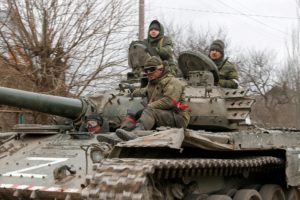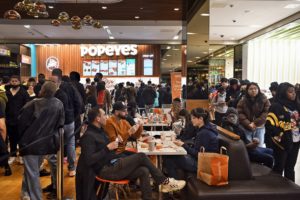
Russian troops in Ukraine
One of the issues in the war between Russia and Ukraine is the insistence by President Putin of Russia that in fact Ukraine is not a “real” country but historically and culturally belongs to Russia. That is part of his stated rationale for the war, along with the concern he continually expresses that Ukraine will join NATO and thus become an enemy on Russia’s doorstep.
Many have debunked the idea that Ukraine does not have a right to be an independent nation. The historical, cultural, and linguistic reasons are laid out nicely in a recent piece by Keith Gessen in the New York Times Magazine. He cites the conversation from one of the posted videos from the war showing a Ukrainian citizen confronting Russian soldiers after their tank runs out of gas on the road to Kyiv. The Ukrainian asks in Russian, “Can I tow you back to Russia?”
Beyond the courage and the sense of humor on display, Gessen comments that the fascinating aspect of the encounter was not so much how it documented the incompetence of the Russian invasion, but rather that the Ukrainian could communicate so easily, so freely, with the Russian soldiers. Not only do many Ukrainians speak Russian, often as their native language, but they switch easily between Russian and Ukrainian, depending on the context and the situation. Although Russian war propaganda makes much of the minority status of Russian speakers in Ukraine, that does not ring true in the everyday life of most Ukrainians:
Russian propaganda claims that the language is discriminated against, and there are people in Russia who believe that you will get shouted at, or even attacked, for speaking Russian in Kyiv. Yet in the videos now emerging from Ukraine, over and over again, people are speaking Russian. Soldiers speak Russian as they fire rocket-propelled grenades at Russian tanks. Locals speak Russian as they survey annihilated Russian columns.
Gessen points out that Americans are likely to associate war with countries far away, where a foreign language is spoken. He points out that this war is altogether different: “Russia invading Ukraine is less like our wars in Iraq or Vietnam and more like the United States invading Canada.”
The President of Ukraine himself, Volodymyr Zelenskyy, switches easily between the two languages. In a speech rebutting Putin’s claim of the shared identity of Ukraine and Russia, he switched to Russian in order to address the Russian people:
Responding to the Kremlin’s claims that it was protecting the separatist regions from Ukrainian plans to take them by force, Zelensky asked whom, exactly, Russia thought he was going to bomb. “Donetsk?” he asked incredulously. “Where I’ve been dozens of times, seen people’s faces, looked into their eyes? Artyoma Street, where I hung out with my friends? Donbas Arena, where I cheered on our boys at the Eurocup? Scherbakov Park, where we all went drinking after our boys lost? Luhansk? The house where the mother of my best friend lives? Where my best friend’s father is buried?”
Zelensky was making the argument that Ukraine is indeed a nation, formed not by history or by language, but by the histories and memories of its people and through personal connections among its citizens. Zelensky continued his speech: “Note that I’m speaking now in Russian, but no one in Russia understands what I’m talking about. These place names, these streets, these families, these events — this is all foreign to you. It’s unfamiliar. This is our land. This is our history. What are you going to fight for? And against whom?”
It is a powerful and effective argument that he is making, insisting that Ukraine is not Russia, but instead its own nation, multiethnic and multilingual, and rooted to a particular place, culture, and history. And one whose continued existence is worth fighting for.














